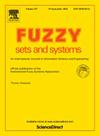ECM+:具有自适应距离的改进型证据 c-means
IF 3.2
1区 数学
Q2 COMPUTER SCIENCE, THEORY & METHODS
引用次数: 0
摘要
证据 c-均值(ECM)是一种基于原型的聚类算法,它能生成一个可信的分区。这种分区包含了硬分区、模糊分区或可能性分区中可能遇到的概念,可以表示与对象的类别成员资格有关的各种情况。ECM 方法为每个可能类别的子集提供了一个原型,该原型是通过平均子集中包含的类别的原型计算得出的。虽然这一定义在使用欧氏距离时非常适合 ECM,但在使用马哈罗诺比距离时就变得不合适了。在这种情况下,我们提出了子集原型的新定义。然后使用新定义的原型对 ECM 目标函数进行优化。最后,在各种合成数据集和真实数据集上测试了名为 ECM+ 的后续算法,以证明其与 ECM 相比的优势。本文章由计算机程序翻译,如有差异,请以英文原文为准。
ECM+: An improved evidential c-means with adaptive distance
Evidential c-means (ECM) is a prototype-based clustering algorithm that generates a credal partition. Such a partition encompasses the notions that can be encountered with a hard, fuzzy or possibilistic partition, allowing the representation of various situations concerning the class membership of an object. The ECM method provides a prototype for each subset of the possible classes, calculated by averaging the prototypes of the classes included in the subsets. Although this definition perfectly suits ECM when employing a Euclidean distance, it becomes inappropriate when using a Mahalanobis distance. In this context, a new definition of prototypes for the subsets is proposed. The ECM objective function is then optimized using the new definition of prototypes. The subsequent algorithm, named ECM+, is finally tested on various synthetic and real data sets to demonstrate its interest compared to ECM.
求助全文
通过发布文献求助,成功后即可免费获取论文全文。
去求助
来源期刊

Fuzzy Sets and Systems
数学-计算机:理论方法
CiteScore
6.50
自引率
17.90%
发文量
321
审稿时长
6.1 months
期刊介绍:
Since its launching in 1978, the journal Fuzzy Sets and Systems has been devoted to the international advancement of the theory and application of fuzzy sets and systems. The theory of fuzzy sets now encompasses a well organized corpus of basic notions including (and not restricted to) aggregation operations, a generalized theory of relations, specific measures of information content, a calculus of fuzzy numbers. Fuzzy sets are also the cornerstone of a non-additive uncertainty theory, namely possibility theory, and of a versatile tool for both linguistic and numerical modeling: fuzzy rule-based systems. Numerous works now combine fuzzy concepts with other scientific disciplines as well as modern technologies.
In mathematics fuzzy sets have triggered new research topics in connection with category theory, topology, algebra, analysis. Fuzzy sets are also part of a recent trend in the study of generalized measures and integrals, and are combined with statistical methods. Furthermore, fuzzy sets have strong logical underpinnings in the tradition of many-valued logics.
 求助内容:
求助内容: 应助结果提醒方式:
应助结果提醒方式:


